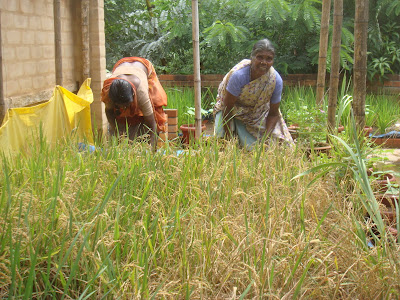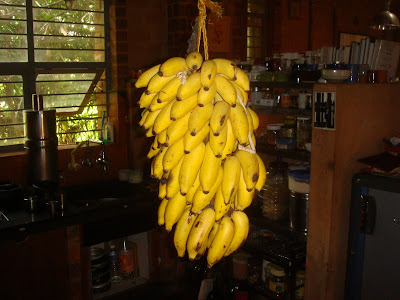
So we took a plastic sheet called Silpaulin actually two of them and put it in as a lining on our roof. About 3 inches of leaf mulch, soil and a bit of vermicopost went in to create the bed. Paddy was planted insitu. No transplantation here. We followed the SRI method

and just about kept the soil wet without flooding it. Of course once in a while the field flooded when it rained.
Then we waited or 3 months . The rice grain came up nice and fat. The urine from the ecosan toilet went in as a nutrient. No other fertilizer was used. We used 1 litre of urine per square metre of planted area.
The rice grain was itself a local variety, which Muthiah our man friday, got from his village.
The squirrels climbed on the roof and got a bit at the grain. The birds had an afternoon peck and they got a bit of a bonus water. We did not shoo them away.
Maryamma (to the right) and her daughter landed up. They have come here for construction but when they saw the rice on the roof they were absolutely bowled. The joy on Maryamma's face was visible. She pugged the soil, pulled the weed and came harvest time descended with 2 suickles and a daughter and got about cutting the paddy with gusto and in doucle quick time it was done.

The grains and the cut grass are here. Thick juicy grains as well as good leaves.
Now how about growing some rice on your roof too? Provides food security, treats all your waste water and turns urine into a nutrient.
If there be a miracle crop on this planet it has got to be rice. A grass whose seeds are the saviours of mankind. Not for naught is it used as a blessing on every occassion.
May you always have rice in your plates and sometimes some on your roof.



 The wells are beautiful and the rings are pottery rings
The wells are beautiful and the rings are pottery rings The houses are clean and well decorated
The houses are clean and well decorated
 Rain barrels, solar panels ragi on the roof and rice on the roof, throw in some bananas and beans a greywater treatment system a solar water heater a solar cooker capture rainwater from the neighbours roof and an ecosan toilet with its own rain barrel. Great way to use a roof space in Bengaluru India.
Rain barrels, solar panels ragi on the roof and rice on the roof, throw in some bananas and beans a greywater treatment system a solar water heater a solar cooker capture rainwater from the neighbours roof and an ecosan toilet with its own rain barrel. Great way to use a roof space in Bengaluru India.





 and just about kept the soil wet without flooding it. Of course once in a while the field flooded when it rained.
and just about kept the soil wet without flooding it. Of course once in a while the field flooded when it rained. The grains and the cut grass are here. Thick juicy grains as well as good leaves.
The grains and the cut grass are here. Thick juicy grains as well as good leaves.




 and the serene life idyllic.
and the serene life idyllic.
